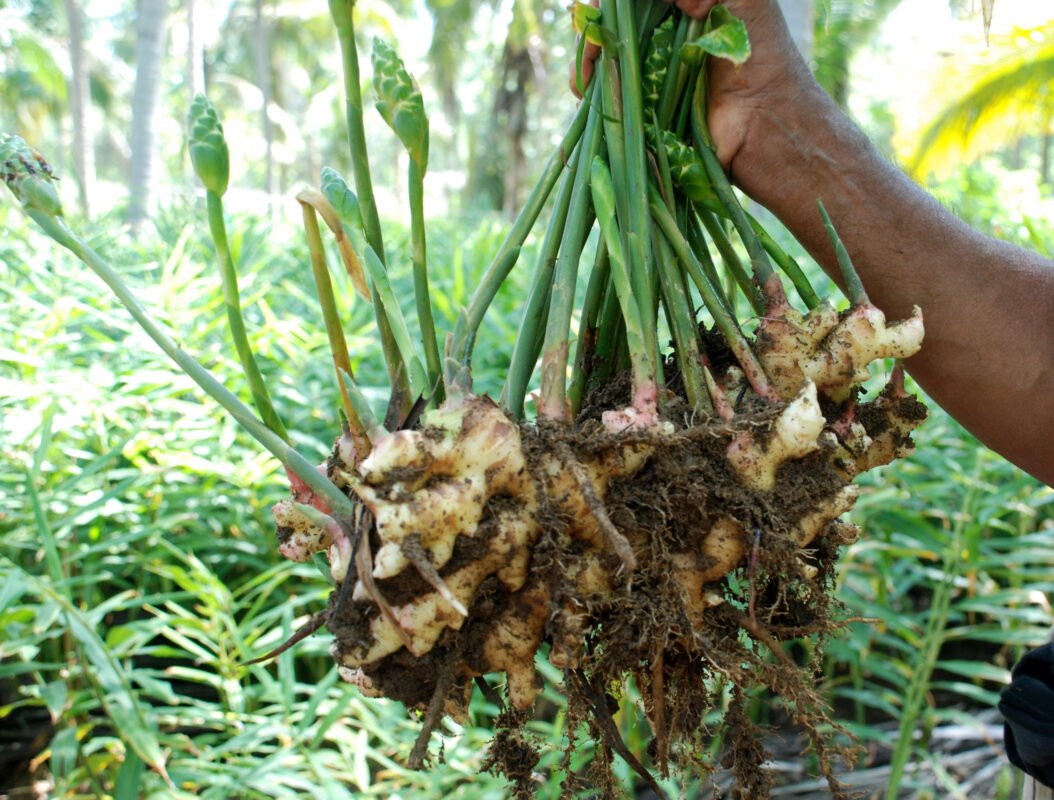Ginger Zingiber Officinale Family: Zingiberaceae

History
Based on the historic records more than 3000 years, ginger is believed to be originated in East Asia. Ginger has been used as a spice from ancient times. It has been widely used in Chinese and in Ayurvedic medicine. There is information that says at the time of ruling of Emperor Nero the Roman army used ginger as a medicine. It was found that ginger was imported to the European countries as a spice by 1547 A.C. In recent years Ginger has been cultivated as a commercial crop in many countries. Countries such as China, India, Australia, Fiji, Hawai, Hongkong, Jamaica, Japan, Nigeria, Pakistan, West Africa, Taiwan are few countries which cultivate Ginger in a large scale.
Major Growing Areas
Ginger is grown in all over the country but wet and intermediate zones are major growing areas. Total cultivated extent in 2019 was 1838 ha. Kurunagala, Kandy, Gampaha, Colombo and Kegalle Districts are main growing areas. ginger is largely grown as an inter- crop with coconut and as a home garden crop. Total production in 2019 was 13785 Mt.
Varieties
Several local and introduced varieties are grown in Sri Lanka in large scale.
Local ginger – Rhizomes are small and the fibrous flesh is somewhat ash white in color. Pungency and aroma are comparatively higher than other ginger varieties. Largely used for beverages
Chinese ginger – Rhizomes are large in size with watery flesh. Flesh is pale yellow in color. The Pungency and aroma is low. Largely used for pickles. Rangoon ginger- Rhizomes are medium in size and with well spreaded finger rhizomes.
Ginger processing
The basic activities of ginger processing are washing, peeling and drying.
Washing
The rhizomes should be washed well removing sand in between the fingers. Ginger can be dried for one day and placed in polypropylene lined poly -sack bags to be issued to the market as raw ginger.
Peeling
Ginger rhizomes should be soaked in water for one night and the outer skin can be removed carefully
Drying
Peeled ginger should be dried for about one week until the moisture percentage is 12%. Dried ginger can be stored in a polypropylene lined poly sack bag.
Products and Uses
Ginger is available in market as fresh ginger or in dry form. Dried ginger is powdered and used for different products. Pickled fresh ginger is popular in East Asian countries and salted and sweetened ginger products are also commonly available in the Asian markets. Ginger oils and oleoresins are used in the food industry as a spice to flavor curries, bakery & other food products and to some extent in the perfumery industry, Also it is a common ingredient in the Ayurvedic medical system till today.
Value added products
Dried ginger
Bleached ginger (siddhi ginger)
Ginger slices
Ginger powder
Ginger oil
Ginger oleoresin
Preserved ginger products
Sweeten ginger slices and salted ginger slices
Ginger chutney
Ginger paste
Ginger in sugar syrup
Medicinal and Chemical Properties
It is proven that man has used ginger as a medicine in the past. In many Ayurvedic remedies Ginger is a main commodity. Not only for common flue but it also works for high blood pressure and as an antidote for cancer.
